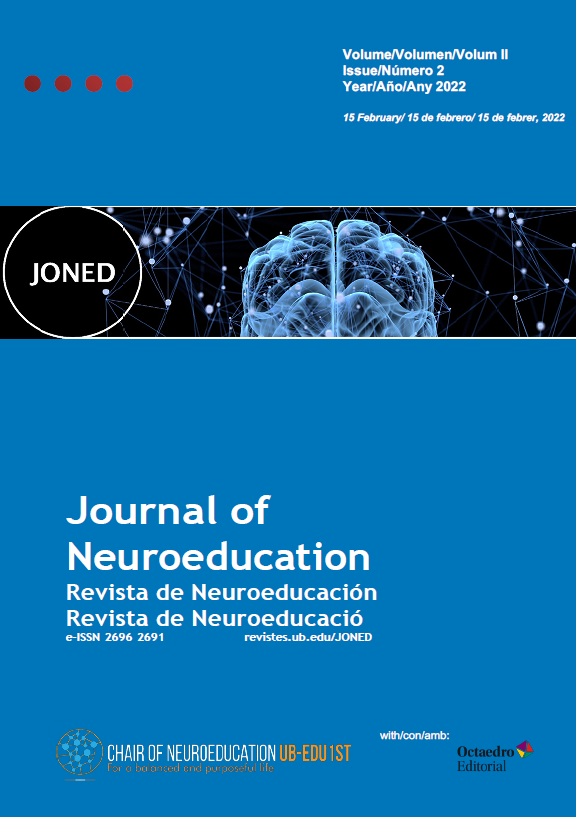La importancia del córtex parietal superior en la aparición del arte y el desarrollo cognitivo
El origen del arte con relación al córtex parietal superior
DOI:
https://doi.org/10.1344/joned.v2i2.37917Keywords:
superior parietal cortex, encephalitisation, development of art, art, anatomyAbstract
The main objective of this work is to study the relationship of the superior parietal cortex (CPS) with the appearance of art, to explore the potential of art as an educational and therapeutic tool in childhood. A systematic review has been carried out in databases such as Pubmed, TripDataBase, Science Direct and Google Scholar. The search strategy was based on exploring the following keywords: Art, Brain, Evolution, Superior Parietal Cortex, Symbolism, Cognition. Through the literature exploration strategy, a total of 420 studies were found. After inclusion and exclusion criteria were applied, only 20 were included in the present article. In this selection, it was observed that the most explored categories treated when addressing the relationship between art and brain were brain size and encephalization (27.27%), the effects of cooking and diet (22.73 %), the superior parietal cortex (22.73%) and symbolic cognition (18.18%). After an exhaustive review of the scientific literature, it should be noted that the variety of investigations in neuroscience, anatomical evolution and cognitive development are not enough to establish a direct relationship between the increase in the superior parietal cortex and the origin of art. Even so, the appearance of art during the encephalization process of the human species leads us to wonder if it is possible that art can be an enhancer of cognitive development and not just a consequence of human encephalization. If so, a greater inclusion of art in the classroom and of art therapy in the Centers for Child Development and Early Attention (CDIAP in Catalonia) could be related to the future cognitive configuration.
References
Enard W. The Molecular Basis of Human Brain Evolution. Curr. Biol. 2016; 26(20), R1109-R1117. doi: 10.1016/j.cub.2016.09.030
Zink KD, Lieberman DE. Impact of meat and Lower Palaeolithic food processing 336 techniques on chewing in humans. Nature. 2016; 531(7595), 500-503. doi: 10.1038/nature16990
Buckner RL, Krienen FM. The evolution of distributed association networks in the human brain. Trends. Cogn. Sci. 2013; 17(12), 648-665. doi: 10.1016/j.tics.2013.09.017
Geschwind DH, Rakic P. Cortical evolution: Judge the brain by its cover. Neuron. 2013; 80(3), 633-647. doi: 10.1016/j.neuron.2013.10.045
Whitlock JR. Posterior parietal cortex. Curr. Biol. 2017; 27(14), R691-R695. doi: 10.1016/j.cub.2017.06.007
Westphal-Fitch G, Fitch WT. Bioaesthetics: The evolution of aesthetic cognition in 345 humans and other animals. Prog. Brain Res. 2018; 237, 3-24. doi: 10.1016/bs.pbr.2018.03.003
Falk D. Evolution of brain and culture: the neurological and cognitive journey from 348 Australopithecus to Albert Einstein. J Anthropol. Sci. 2016; 94, 99-111. doi: 10.4436/JASS.94027
Page, M. J., McKenzie, J. E., Bossuyt, P. M., Boutron, I., Hoffmann, T. C., Mulrow, C. D., ... & Moher, D. (2021). Declaración PRISMA 2020: una guía actualizada para la publicación de revisiones sistemáticas. Revista Española de Cardiología, 74(9), 790-799.
Morriss-Kay GM. The evolution of human artistic creativity. J. Anat. 2010; 216(2), 158-176. doi: 10.1111/j.1469-7580.2009.01160.x
Bruner E. Human paleoneurology and the evolution of the parietal cortex. Brain Behav. 353 Evol. 2018; 91(3), 136-147. doi: 10.1159/000488889
Neubauer S, Hublin JJ, Gunz P. The evolution of modern human brain shape. Sci. Adv. 2018; 4(1). doi: 10.1126/sciadv.aao5961
Navarrete A, Van Schaik CP, Isler K. Energetics and the evolution of human brain size. Nature. 2011; 480(7375), 91-93. doi: 10.1038/nature10629
Lesciotto KM, Richtsmeier JT. Craniofacial skeletal response to encephalization: How do we know what we think we know?. Am. J. Phys. Anthropol. 2019; 168 Suppl 67(Suppl 67), 27-46. doi: 10.1002/ajpa.23766
Pereira-Pedro AS, Rilling JK, Chen X, Preuss TM, Bruner E. Midsagittal Brain Variation among Non-Human Primates: Insights into Evolutionary Expansion of the Human Precuneus. Brain Behav. Evol. 2017; 90(3), 255-263. doi: 10.1159/000481085
Bruner E, Preuss TM, Chen X, Rilling JK. Evidence for expansion of the precuneus in human evolution. Brain Struct. Funct. 2017; 222(2), 1053-1060. doi: 10.1007/s00429-015-1172-y
Demarin V, Bedeković MR, Puretić MB, Pašić MB. Arts, Brain and Cognition. Psychiatr Danub. 2016; 28(4), 343-348.
Rode G, Vallar G, Chabanat E, Revol P, Rossetti Y. What do spatial distortions in patients’ drawing after right brain damage teach us about space representation in art? Front. Psychol. 2018; 9, 1058. doi: 10.3389/fpsyg.2018.01058
Berlucchi G, Vallar G. The history of the neurophysiology and neurology of the parietal lobe. Handb. Clin. Neurol. 2018; 151, 3-30. doi: 10.1016/B978-0-444-63622-5.00001-2
Zaidel DW. Art and brain: Insights from neuropsychology, biology and evolution. J Anat. 2010; 216(2), 177-183. doi: 10.1111/j.1469-7580.2009.01099.x
Wu Y, Wang J, Zhang Y, Zheng D, Zhang J, Rong M, Wu H, Wang Y, Zhou K, Jiang T. (2016) The neuroanatomical basis for posterior superior parietal lobule control lateralization of visuospatial attention. Front. Neuroanat. 10, 32. doi: 10.3389/fnana.2016.00032
Cela-Conde CJ, Ayala FJ. Art and brain coevolution. Prog. Brain Res. 2018; 237, 41-60. doi: 10.1016/bs.pbr.2018.03.013
Zaidel, DW. Art and brain: The relationship of biology and evolution to art. Prog. Brain Res. 2013; 204, 217-233. doi: 10.1016/B978-0-444-63287-6.00011-7
Cattaneo Z, Lega C, Gardelli C, Merabet LB, Cela-Conde CJ, Nadal M. The role of prefrontal and parietal cortices in esthetic appreciation of representational and abstract art: A TMS study. Neuroimage. 2014; 99, 443-450. doi: 10.1016/j.neuroimage.2014.05.037
Downloads
Published
Issue
Section
License
Copyright (c) 2022 Aroa Casado Rodríguez, Nuria Sánchez Cayuela

This work is licensed under a Creative Commons Attribution-NonCommercial 4.0 International License.
The authors who publish in this journal agree to the following terms:
a. Authors retain copyright and grant the journal the right of first publication
b. Texts will be published under a Creative Commons Attribution Non Commercial License that allows others to share the work, provided they include an acknowledgement of the work’s authorship, its initial publication in this journal and the terms of the license, and not for commercial use.



